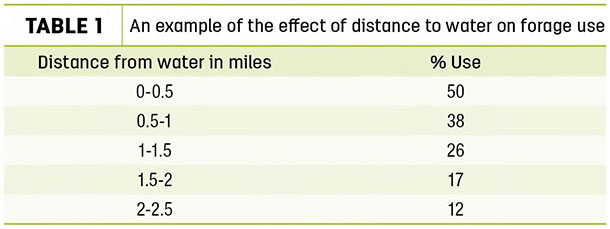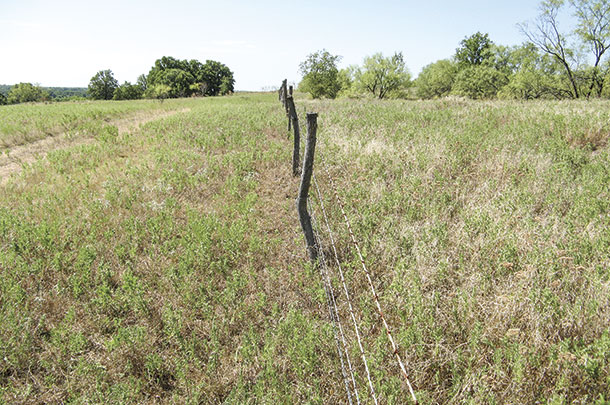Cattle, however, are like many people in their eating habits. They prefer certain foods (plants) over others and don’t like to eat anything they haven’t previously tasted. To achieve good grazing distribution, it is important to manage cattle so they eat spinach along with the ice cream.
Another reason for undesirable grazing distribution is: Cattle become more comfortable with certain areas of a pasture than others. Stock density, distance from water sources to feeding areas, terrain, amount of shade, insect pests, predators and human activity also factor into grazing distribution.
“Research studies suggest cattle quickly explore a new area, develop map-like representations of the locations and file the information in their long-term memory. The filed information changes more slowly than quantity and quality of forage, so they often revisit areas where forage has been depleted,” said Robert Lyons, Ph.D. and range specialist with Texas A&M AgriLife extension service.
“Cattle and other grazing animals appear to use short-term memories to recall sites they have visited in the last eight hours or less.”
When introduced to an unfamiliar type of range, the new animal will spend more time grazing but eat less than cattle familiar with the area. Moving animals from one type of vegetation or topography to a very different type of range can reduce performance until the cattle become accustomed to the new environment. Adaptation may take up to one year.
Distance to water
Insufficient water availability is a major cause of poor grazing distribution. Data in Table 1 show water sources are the central points of grazing activity.

Plant consumption is the heaviest near water and decreases as distance from water increases. Effects of location and number of watering points on grazing distribution are influenced by vegetation type, topography, season and kind, class and age of the animals.
“Water requirements by cattle increase as their weight, lactation, physical activity, salt intake and dry matter consumption increase,” said Rick Machen, Ph.D., King Ranch Institute for Ranch Management. “Their water intake requirements increase with rises in ambient temperature as well. Less water is required when forage has a high moisture content, and some animal species and breeds use water more efficiently than others.
“More energy is used by cattle when they are required to travel long distances between forage and water. Young suckling calves are most susceptible to lack of water availability because of reduced milk production by their mothers. Calves are less likely to travel long distances to water on hot days.”
Grazing management is often enhanced by improving water accessibility. Water sources can be added by drilling wells, adding pipelines and building drinking troughs. An alternate approach is to create earthen tanks or ponds that capture and store surface runoff.
“In rough, steep terrain, cattle should not have to travel more than half a mile from forage to water. On a level or gently rolling landscape, we prefer stock not to travel more than a mile,” said Machen. “Plan a watering facility to allow the entire herd to drink in 20 minutes or less.”
Other grazing distribution factors
“The second-most important cause of poor grazing distribution is topography,” said Lyons. “Cattle seldom use areas with greater than 10 percent slope, but they will cross steeper areas if there is easy access and contours that cross the slopes. Yearling cattle are more agile than mature cows and will travel further and use more rugged terrain. Cattle will graze on slopes during certain seasons of the year, which suggests they are unwilling to graze slopes rather than unable.”
Forage species play a major role in grazing distribution. Plants with the most palatability or accessible green leaf material will receive the greatest grazing pressure. Even in a grass monoculture, cattle may not graze plants uniformly. Plants normally produce preferred, succulent new growth after grazing. As a result, cattle repeatedly utilize the same plants and tend to avoid areas not previously grazed or areas soiled with feces or urine.
Riparian areas are favorite grazing sites for cattle because they offer a variety of high-quality forage plants that are highly palatable and close to water and loafing cover. Plants in riparian areas tend to stay green longer than those in adjacent areas.
“Grazing is often limited by weather conditions such as temperature, snow and excessive rainfall. When temperatures exceed 85ºF, cattle will walk greater distances to find shade,” said Machen. “Cattle routinely seek shade around midday on hot summer days. Bos indicus-influenced cattle are more heat-tolerant and less shade- dependent than longer-haired Bos taurus breeds. Cattle with dark hair coats tend to seek shade earlier and for longer periods. Cattle tend to stay around water if shade is available.”
Research has shown provision of shade to improve summer-long weight gain in yearling steers. Artificial shade may help attract animals to undergrazed forage in areas with few trees or tall shrubs. Results have been inconsistent, however, with using artificial shade to improve grazing distribution.
Additional management practices
“Forage palatability and length of the green period is increased by removing unpalatable plant species and old growth. Palatability improvement could attract cattle into previously ungrazed or undergrazed areas,” said Lyons. “Prescribed burning is one method of improving palatability because it removes old plant growth, thus making new growth more accessible. It is wise to defer grazing on burned areas to allow time for vegetation to establish leaf material and sustain root growth.”
Nitrogen fertilizer is known to lengthen the green period and improve palatability of some plant species. Economics of fertilizing native grasses only to improve grazing distribution is questionable, however. Justification for this practice must include the potential to increase forage production that will result in profit improvement.
“Fencing is a direct way to alter grazing distribution,” continued Lyons. “Fences can separate areas that need different management strategies such as riparian zones, irrigated pastures or land subject to seasonal use. Fences are also used to divide large pastures into more manageable units and to facilitate rotational grazing.”

When establishing fences, make the best use of existing or planned watering points. If possible, permanent water facilities should serve more than one pasture. Consider the range site and potential forage production to ensure each fenced area has enough watering points.
Supplemental feeding can act as a grazing management tool in addition to providing cattle with nutrients not available in the forage. Protein and energy supplements (including blocks and tubs) or salt-meal mixes are usually more effective in influencing grazing patterns than salt alone. Pelleted or cubed supplements can be fed on the ground or in movable bunks to move cattle to poorly used areas.
“Each ranch is unique in regard to grazing distribution challenges,” Lyons said in summary. “Ranchers should focus on optimizing grazing distribution and harvest efficiency. Effective and efficient grazing management comes from experience acquired through keen observation and is accompanied by sound stockmanship.” ![]()
PHOTO 1: Cattle seldom use areas with greater than 10 percent slope.
PHOTO 2: Fencing is a direct way to alter grazing distribution. Photos by Robert Fears.
Robert Fears is a freelance writer based in Georgetown, Texas. Email Robert Fears.







